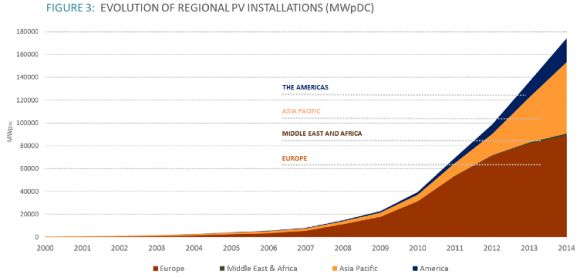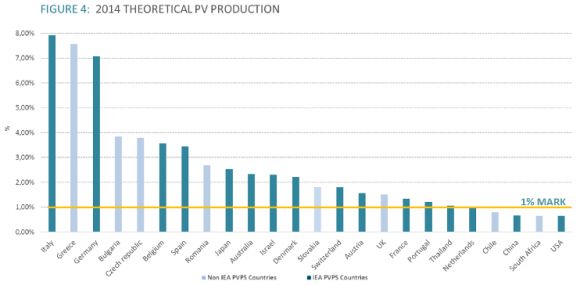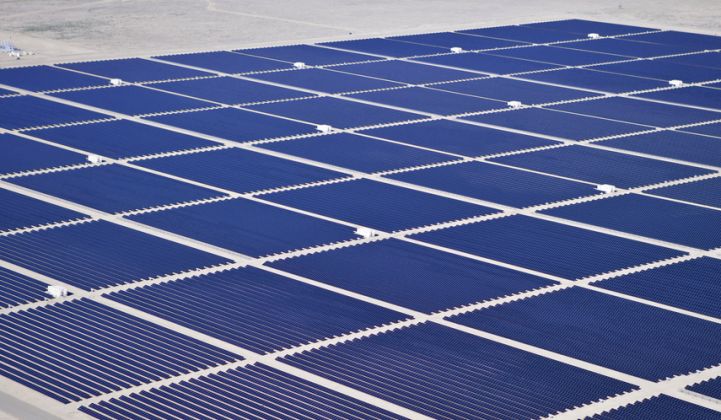By the end of 2014, total installed capacity for solar PV globally amount to at least 177 gigawatts, up from nearly 140 gigawatts in 2013, according to the International Energy Agency's Photovoltaic Power Systems Programme (IEA-PVPS).
Countries in the IEA-PVPS network that are engaged in collaborative efforts to grow the PV market reported 155 gigawatts of cumulative solar installations at the end of 2014. Countries outside of the PVPS program, which the IEA tracks through industry groups as opposed to official government bodies, installed at least 22 gigawatts of additional capacity.
There is at least 10 times more solar PV installed around the world today than in 2008. These global installations are now producing more than 1 percent of the electricity used on the planet.

Source: IEA PVPS
But while the global solar PV market continues to grow, last year's performance didn't quite meet expectations.
The IEA's preliminary data released yesterday shows the global PV market saw a modest increase year over year, from 37.6 gigawatts in 2013 to 38.7 gigawatts in 2014.
The market in Europe decreased significantly, from 22 gigawatts in 2011 to around 7 gigawatts in 2014. Germany saw a decline to 1.9 gigawatts of new installed solar. Italy's market, where the feed-in tariff was phased out, declined to 400 megawatts. Markets that had previously seen gigawatt-scale growth -- Spain, Czech Republic, Belgium, Greece and Bulgaria -- screeched to a halt, with either nothing or just a few megawatts of new solar PV installed in 2014.
Overall, European markets installed at least 4 gigawatts less last year than in 2013.
In China, the solar PV market saw significant growth, but did not hit the 14-gigawatt target some believed it could have reached. China revised its PV targets down in 2013, from 12.92 gigawatts to 10.95 gigawatts. In 2014, the Chinese solar market reached 10.6 gigawatts.
Ultimately, the global PV market could have been larger than what it achieved "if Europe could have maintained its market level and China fulfilled expectations," according to the IEA.
Modest global PV expansion
This year could be a different story. China's National Energy Administration recently announced the country plans to install as much as 17.8 gigawatts of solar projects in 2015. The world's largest polluter has also put a new policy focus on distributed solar and innovative financing tools to help meet its goals.
And while China didn't meet expectations in 2014, it still claimed the top spot in terms of new solar installations. Japan came in second with 9.7 megawatts, and the United States came third with 6.2 gigawatts. According to GTM Research, the U.S. total is up 30 percent from 4.77 gigawatts in 2013.
Solar adoption is also starting to see more global expansion, although progress has been slow. Europe continues to lead the market in overall installed capacity, but Asia's share has started to grow rapidly. The Middle East is also starting to see more activity, led by Israel with around 250 megawatts of solar installed last year. Also, Dubai announced a 100-megawatt project last year with the lowest-cost PPA ever granted -- $58.5 per megawatt-hour.

Source: IEA PVPS
Today, 19 countries produce at least 1 percent of their electricity from solar PV. Italy, Greece and Germany are the top three countries, with solar making up 7.92 percent, 7.6 percent and 7.0 percent of their markets, respectively. The IEA calculated production figures based on each country's cumulative PV capacity at the end of 2014, project siting and average weather conditions.
Declining technology and installation costs in recent years have put solar PV on the radar for policymakers in an increasing number of countries. Targets to boost solar PV production have grown dramatically all over the world. But this has had little effect on deployment. The IEA notes that PV development in 2014 remained concentrated in 40 countries.
All signs indicate the global PV market will continue on an upward trajectory for years to come. Exactly how much growth and where it will take place is less certain.

Source: IEA PVPS



